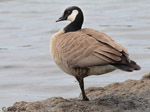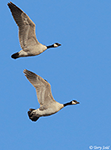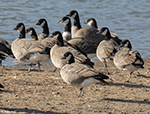Cackling Goose
Branta hutchinsii
| Length: 23 - 26 inches | Wingspan: 40 - 45 inches | Seasonality: Migration/All Seasons |
| ID Keys: Obviously smaller than Canada Goose, shorter stubbier bill, no white neck band, round head | ||
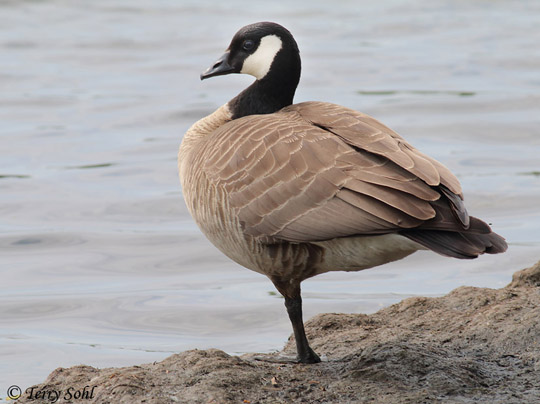 Until
recently, the Canada Goose was considered a
variable species which included four smaller sub-species. Genetic analysis
revealed that these smaller birds were genetically distinct, and they were thus
grouped into a distinct species, the Cackling Goose. When seen together,
the size differences are obvious, as are the shorter neck, stubbier bill, and
rounder head. Cackling Geese breed further to the north and west than
Canada Geese typically do. There are
multiple subspecies, with all but the Aleutian lacking the white neck band that
many Canada Geese have.
Until
recently, the Canada Goose was considered a
variable species which included four smaller sub-species. Genetic analysis
revealed that these smaller birds were genetically distinct, and they were thus
grouped into a distinct species, the Cackling Goose. When seen together,
the size differences are obvious, as are the shorter neck, stubbier bill, and
rounder head. Cackling Geese breed further to the north and west than
Canada Geese typically do. There are
multiple subspecies, with all but the Aleutian lacking the white neck band that
many Canada Geese have.
Habitat:
Different subspecies breed in different habitats, but typically along ponds and lakes or coastal wetlands. In migration and winter, can be in a variety of habitats, often feeding in grain fields as do other geese.
Diet:
Eats entirely plant matter, including seeds, waste grain, grasses and forbs, and berries.
Behavior:
Will feed on land or in the water. In the water, typically feeds by swimming on the surface and tipping to reach food items below the surface. On land, will forage in open fields and agricultural lands.
Nesting:
Cackling Geese breed in the far northern Arctic tundra of Alaska and Canada. The nest of a Cackling Goose begins as a scrape on the ground, typically in a grassy tussock near the shore of a tundra lake. The nest is lined with grasses, moss, and other vegetative material, and then lined with downy feathers. The female lays between 2 and 8 eggs, and she alone incubates them, although the male stays near the nest and defends it from intruders. The young hatch after about 26 days, and soon leave the nest, tended to by both parents.
Cackling Geese form strong family bonds, with mating pairs bonded for life. They stay together not only during the breeding season but also in migration and during the winter months. The young also stay with the parents for a long time, typically staying near their parents for up to a year after hatching. Thus small pods of migrating Cackling Geese found in South Dakota are most likely family members.
Song:
Similar honking to Canada Geese, slightly higher in pitch.
- Click here to hear a lone Cackling Goose in flight1
- Click here to hear a lone Cackling Goose in flight2
Migration:
Winters throughout much of the western half of the United States. In summer, breeds in northern and western Alaska, and northern Canada. In South Dakota, Cackling Geese are migrants and winter visitors.
Interactive eBird Map:
Click to access an interactive eBird map of Cackling Goose sightings
Similar Species:
Cackling Goose are obviously similar to the Canada Goose, given they were once considered the same species, but there's another small goose too they could potentially be confused with:
- Canada Goose - The big brother of the Cackling Goose, Canada Geese are indeed larger than their smaller cousins, but there's a very large size range for Canada Geese, and some smaller Canada Geese may begin to approach the size of a Cackling Goose. Particularly in the field, unless the two species are side by side, it can be very difficult to use size to identify species. The head is the first place to look, as Canada Geese have a longer bill than a Cackling Goose, and a sloping forehead that's much more gradual than that of a Cackling Goose, as they have a steeper forehead. The neck of a Cackling Goose is noticeably shorter than that of a Canada Goose. In South Dakota, season is also a clue. If you see a bird in the summer months, it's a Canada Goose. Cackling Geese are only found here in migration or in winter.
- Brant - Brant are rare visitors to South Dakota, but are another small, compact goose species. The easiest way to differentiate them is the head, neck and breast. A Brant has a head, neck, and breast that is almost completely black, except for a small amount of white on the side of the neck. A Cackling Goose has black restricted to the head and neck (not on the breast), and has a white chinstrap lacking on a Brant.
 |
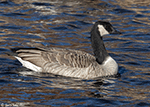 |
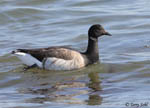 |
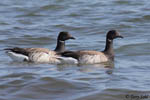 |
| Canada Goose | Canada Goose | Brant | Brant |
Conservation Status:
Systematic surveys don't show any real trends in overall populations. Cackling Geese are found across a broad geographic area, and are common in parts of that range. The IUCN considers the Cackling Goose to be a species of "Least Concern".
Further Information:
Photo Information:
Photo taken on May 22nd, 2014 near Anchorage, Alaska - Terry Sohl
Audio File Information:
- 1Paul Marvin. Recorded in Humboldt County, California on January 27th, 2017. Original recording and information available from xeno-canto.
- 2Andrew Spencer. Recorded in Nome Census Area of Alaska on May 24th, 2013. Original recording and information available from xeno-canto.
| Click on the map below for a higher-resolution view |
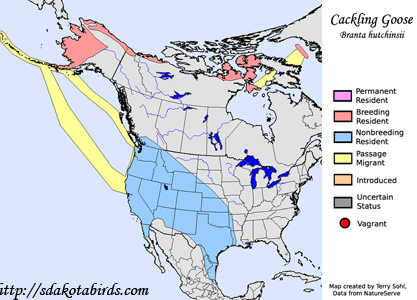 |
| South Dakota Status: Probably only a winter visitor. |
Additional Cackling Goose Photos
Click for a higher-resolution version of these photos
